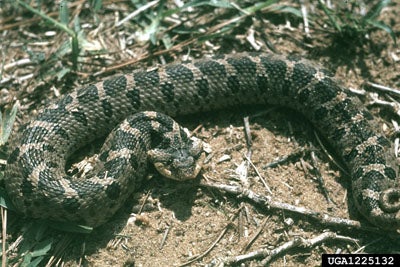SCIENTIFIC NAME:
Heterodon platirhinos
STATUS:
Statewide in distribution. MODERATE CONSERVATION CONCERN.
DESCRIPTION:
Eastern hognose snakes are called “hognose” because of their upturned snout and broad head. Coloration varies from almost uniformly black, to brown, to olive, or grey; or they may have irregular patterns of dark blotches down the back, alternating with dark spots on each side. Their background coloration is sometimes mottled with many colors including yellow, brown, gray, olive, orange, or red. The underside of their tail is usually a lighter color than the rest of their belly. They are thick bodied snakes that may reach 46 inches in length, but usually are 20-30 inches long. Females have a fine tapered tail, while males have a slight bulge near the cloacae from which the tail tapers off drastically. Their scales are keeled. Young hognose snakes are yellow to tan with light grayish-brown blotches, and their bellies are a dark slate color.
DISTRIBUTION:
Hognose snakes can be found in the eastern half of the United States from southern Florida north to central New England, the Great Lakes Region, and some regions of southern Canada. They may be found throughout Alabama, but are more common in woodlands with sandy soil, fields, farmland, and coastal areas.
FEEDING HABITS:
The hognose snake diet, in most areas, is almost exclusively made up of toads. Occasionally, they consume salamanders, small mammals, birds, and a variety of invertebrates. They seem to be immune to the poisons produced by toads, and are equipped with large fangs, in the back of their mouth which are used to puncture inflated toads so they can be swallowed more easily.
ECOLOGY:
Hognose snakes exhibit a most unusual bluffing behavior when threatened. This bluffing behavior usually begins with the snake inflating its head and coiling. It will hiss loudly and strike with its mouth closed. If this display fails to scare a potential predator away, the hognose snake will play dead by rolling over on its back with its mouth open and its tongue hanging out. It also may release a foul smell. If a snake which is “playing dead” is rolled over onto its belly, it will immediately roll back over onto its back and continue to play dead. If it continues to be molested, it will regurgitate its stomach contents (usually partially digested toads) and writhe around in them. Few predators will then continue to consider it a potential meal because of the toxins produced by the toads. It will stay in this position until it feels safe, then, after having a look around, it will move away. Hognose snakes are active by day, and often are seen crossing roads during the spring and fall. They become sexually mature at about two years of age. In the spring, females lay 15-25 eggs in a depression formed in sandy soils under rocks or logs. The eggs incubate for approximately 1-2 months.
CONSERVATION STATUS:
Hognose snakes are common in Alabama and are not protected by state or federal regulations. They can, however, be confused with southern hognose snakes, Heterodon simus. Southern hognose snakes are a rare species in Alabama which is protected by state nongame regulation 220-2-.92.
REFERENCES:
Kingsbury, B. The Center for Reptile and Amphibian Conservation and Management, Eastern Hognose Snake, Indiana-Purdue University.
Tarter A., revised by Wilson, J.D. Snakes of Georgia and South Carolina, Eastern Hognose Snake, University of Georgia Savannah River Ecology Laboratory.
AUTHOR:
Jeff Makemson, Certified Wildlife Biologist, Division of Wildlife and Freshwater Fisheries






